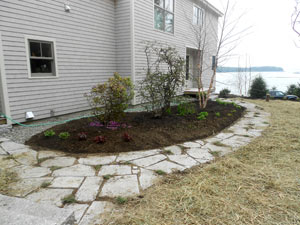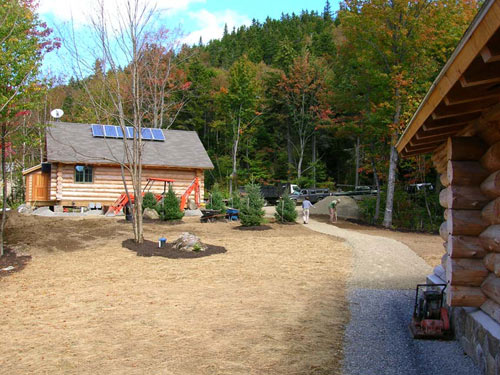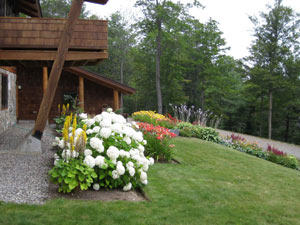
We have a bumper sticker on our truck “Let’s stop treating our soil like dirt”… usually gets a smile from folks. There is truth to that message, that most people should bear in mind. Your soil is the foundation of your garden ~ much like the foundation of a house. If the foundation is poor and failing, all the window dressing in the world won’t hold up over the long haul. Healthy, nutrient rich soils produces healthy plants. Adding organic matter is the best way to maintain the composition of the soil. Organic matter added can be as simple as leaf waste, grass clippings, and manure.
One great way to add those nutrients to soil is through a commercially produced compost product. Some compost benefits:
Obviously, tilling in the compost prior to planting is the best way to ensure an even amount amongst the area, but if you have a garden already in place that you think could use this benefit, topdressing around plants or over turf is helpful and can be done right off in the spring.
The question then becomes which product do I use?

Well, if you have your own compost bin that you’ve been adding to and turning that’s great, adding manure to it is also good. If you lack the time and space, there are a number of products produced right here in Maine that are worth noting:
Right in New Sharon, is Living Acres – they make a wonderful organic compost product and sell it bagged locally. If you need a quantity of it, they sell it by the yard as well, it costs about $100/yd.
Produced in Unity Maine is a line of compost products from a company called New England Organics. They produce on a much larger scale and their compost is available by the yard for about $18.00/yd. As they use a combination of materials, including municipal waste, some people are opposed to using their product in vegetable gardens. I have seen information from the DEP that does not restrict its use, due to the composting process involving the components in the mix. Certainly for ornamentals and turf I highly recommend their products, and do use them in our planting work.
Also from Maine, is the Coast of Maine compost line. Very nice packaging and marketing make their product stand out in a garden center. The analysis of it is very good as well. I have been tempted to try their line, but have what I currently need in the other two companies noted. I would certainly recommend them never the less.
We have several local producers of compost right in most any town around Maine, check around to see what they are offering in the months to come!
So you do have some options for “beefing up” your soil with compost. Unsure just what to add, have a soil test done. We have test kit information here at our office (and can answer other questions for you if you need), or you can pick a kit up at any extension office. The soil sample needs to be mailed off to the lab at Orono, and it will take about 3 weeks to get your results back, but the $12 fee is money well spent to learn what your soils are lacking so you spend money putting in what you really need without the guesswork.

So what about inorganic fertilizers? They are great if used properly. They are a concentrated way to get nutrients into the soil for use by plants, and when used in conjunction with organic matter provide ongoing support for healthy plants. Inorganic fertilizers can be either liquid or granular, and proper application of these is important, as they are immediately available for the plants’ use, and can “burn” them if overapplied. Commercially produced fertilizers always have an analysis on their label. This analysis has 3 primary numbers and usually looks something like this:
20-10-10
This means the product contains 20% nitrogen(N), 10% phosphorus(P), 10% potassium(K). These are the three primary mineral elements necessary for plant growth. All of these exist naturally in the soil, but may not be immediately available for use by plants.
The temptation for many people in the spring is to green up, especially turf, with something that is high in nitrogen – if you look at a garden center there will usually be bagged turf fertilizers saying “quick green up” formula. Not having enough of the next two elements can produce an imbalance in plants that will ultimately make them weak under stress. (Here’s where that $12 test can come in handy). Rule of thumb, for turf, add about 1 lb of actual nitrogen over 1,000 sf of surface area (without a soils test).
It is the nitrogen content that dictates the amount of pounds of fertilizer used. So if you have a 50 lb bag of fertilizer that is noted above as 20-10-10:
Confused? Measure your lawn, do a soils test, give me a call…
And what about phosphorus? Its been getting a bad wrap from DEP of late. Phosphorus exists naturally in all soil. For new lawns and plantings, phosphorus that is immediately used by the plants from fertilizers is key for establishment. After initial installation, you can back off of the amount of phosphorus added when you fertilize because it is already existing naturally. The main problem with phosphorus pollution in our lakes and rivers is from soil erosion. As the phosphorus is in the soil, it then fertilizes the algae in the water and causes it to bloom. The best way to avoid this form of pollution is to keep the soil out of the water! While low amounts or no phosphorus fertilizers are fine for existing plants, newly planted turf and plants need phosphorus that is readily available to them so use fertilizers containing it. Remember to apply it responsibly!
Where does lime fit in? Lime adjusts the pH(acidity) of the soil. If the pH isn’t in the “normal” range (we’ll get to this) the micro and macro nutrients cannot be made available to the plants; they are locked up so to speak. By bringing the pH up with lime, they become available to the plants. Most soils here are quite low in pH, but a soils test will tell you for sure how much you need.
What is normal? Ranges for pH can be as low as 4.5 and up to 8.5. A pH of 6.5-7 is ideal for growing grass. Some plants like a lower pH, like evergreens, hydrangeas and blueberries. Others prefer a slightly higher pH. Many gardening books can answer specific plant questions about levels.
So now is the time everyone wants to get going with gardening and plants. Don’t ignore the foundation. A little time spent early on with soil testing, analysis, and amending will go a long way toward making your plants healthy and beautiful all season long!


